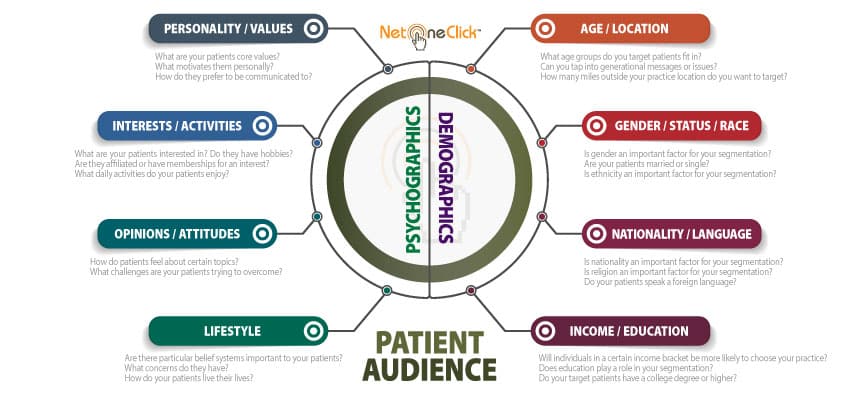Enhancing the Personal Connection through Patient Audiences
In order to build a competent strategic medical marketing plan it is best to start with identifying your patient categories. You have many different patient categories important to your practice. It is helpful to take your patient data and begin to segment your patients into “audiences”, or sub-categories, so you can better communicate your practice value and brand message. These Patient Audiences will help you target and create relevant content for their specific profile.
Creating Your Patient Audience Profiles
It is very easy to become overwhelmed at the sheer amount of technology we have at our fingertips today. You have seconds to capture your patient’s attention. You need to be able to anticipate where your patients will be and what your patients are interested in. In order to position your practice effectively, you need a clear picture of your who your patient is and what they care about.
Who is most likely going to be attracted to your practice brand, service message or offer? You may operate within a city of hundreds of thousands of people with a high level of competing practices. The city is your market but your practice has a unique opportunity to attract a specific type of patient. Those patients have friends and family like them and are more likely to refer to your practice if you fit into their category. Focusing and defining your patient audiences doesn’t prevent you from having patients outside of those categories. It simply helps you use your marketing resources effectively.
When defining your Patient Audiences, your job is to identify the characteristics that your largest and most profitable patient groups fit into. These Patient Audiences will be defined by both demographic and psychographic characteristics.
Demographic Characteristics
Demographic characteristics include categories such as race, age, gender, income, regional location, employment status, education level and so on.
- Age range: What age groups do you target patients fit in? Can you tap into generational messages or issues?
- Location: How many miles outside your practice location do you want to target? 10 miles? 25 miles?
- Married: Are your patients married or single?
- Ethnicity: Is ethnicity an important factor for your segmentation?
- Nationality: Is nationality an important factor for your segmentation?
- Gender: Is gender an important factor for your segmentation?
- Religion: Is religion an important factor for your segmentation?
- Income: Will individuals in a certain income bracket be more likely to choose your practice? If so, what income bracket is appropriate for target patient segments?
- Education: Does education play a role in your segmentation? Do your target patients have a college degree or higher?
- Language: Do your patients speak a foreign language?
Have you mapped your location demographics? Search for your city here: https://www.census.gov/quickfacts/fact/table/US/PST045217
Psychographic Characteristics
Psychographic characteristics relate to the personality characteristics such as personality, personal values, interests, activities, opinions, attitudes, and lifestyle.
- What are your patients core values? What motivates them personally?
- What are your patients interested in? Do they have hobbies? Are they affiliated or have memberships for an interest?
- Are there particular belief systems important to your patients? What concerns do they have? Example: An ObGyn might want to target patients interested in natural birth or breastfeeding.
- How do your patients live their lives?
- What challenges are your patients trying to overcome?
- What daily activities do your patients enjoy?
- How do patients feel about certain topics? Example: A functional medicine practice might want to target people interested in a plant-based diet or natural approach to living.
Developing Content for Your Audiences
After you have segmented your patients into categories. Ask yourself:
- What topics might interest patients? What issues would they like to know more about?
- How can you provide them more content about these topics?
- What is the best way to deliver this type of content? (blog, email, phone app, software tool, print mailing)
- What resources will you need to generate this content? (budget, internal experts, hired consultants)
- What resources will you need to deliver this content? (expert help, website, developers)
- How can you measure the impact of this content on the practice? (new patient numbers, website traffic, social analytics)
Jumping into marketing without consideration of your patient profile can be wasteful. The patient journey begins with your communication with the patient. Whether it is through your marketing campaigns, medical practice website, over the phone or when they check-in. When patients truly connect with their healthcare providers they often rave about their experience. This starts with identifying who will most be attracted to your practice. When you create engaging healthcare marketing and advertising, you draw a patient into your office. When you create a connection with your patient, you enhance their journey. Combining these two elements is a powerful force in building your brand and growing a successful medical practice.

